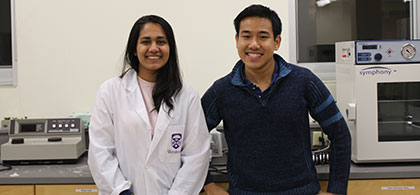Western Heads East in the News
Notice
After careful review of the program and its alignment with Western’s strategic goals and priorities, Western International has made the difficult decision to retire the Western Heads East program. See full notice.
Current Research: Assessing Effectiveness of Different Probiotic Foods
Toby Le was a Western Heads East intern in summer 2017 where he worked with Mikono Yetu Center for Creativity and Innovation, a women’s empowerment NGO in Tanzania, to support women’s groups who produce Fiti probiotic yogurt.
Flash forward to 2019 you can find Toby still fully involved with Western Heads East; just now he is working in Dr. Sharareh Hekmat’s lab at Brescia University College on research related to the program. In this interview, Toby shares about his involvement with Western Heads East, and the exciting research he is doing on assessing the effectiveness of different probiotic foods.
Tell us a bit about yourself.
My name is Toby Le and I’m a fourth-year student in Medical Sciences with an honors specialization in Microbiology and Immunology at Western University. Moving forward, I want to pursue a career that enables me to contribute to global health research by exploring different treatments, therapies, and sustainable health models that can help low-income groups overcome poverty-related diseases.
How did you get involved with Western Heads East?
I was an intern of Western Heads East in 2017, where I had the opportunity to work with rural women and community leaders to expand the consumption of probiotics in Tanzania. As a team, we introduced probiotics to different non-profit organizations, orphanages, and rural communities. We educated these groups about probiotics and trained them on how to produce and sell probiotic yogurt to economically empower themselves, as well as improve the health of their community members.
What are probiotics? What is Fiti?
Probiotics are live microorganisms that when administered in adequate amounts, confer a health benefit on the host. Fiti is the name given to a yogurt containing the probiotic strain called Lactobacillus rhamnosus GR-1. This strain was isolated from a healthy woman in 1981 in Kingston, Ontario. It was then studied by Dr. Gregor Reid, Dr. Andrew Bruce and others to the point where it is one of the world's most documented probiotic organisms. When Western Heads East was established, it was decided to create Africa's first probiotic yogurt using the GR-1 strain. In 2004, Western Heads East helped to establish the first community kitchen in Mwanza, Tanzania where local women were taught how to produce the GR-1 probiotic yogurt and they named it Fiti. In recent years, a partnership with Yoba-for-life Foundation made it possible to have a sachet containing the GR-1 strain, plus a starter culture of Streptococcus thermophilus to ferment the milk, cereal or juice. A large IDRC grant made it possible to reach over 260,000 consumers weekly in Tanzania, Kenya, and Uganda, with an expansion now underway in Rwanda. Case studies have documented the incredible benefits including economic empowerment of women and youth, and establishment of value chains that make man a part of the social enterprise.
 Tell us about your current research on probiotic foods.
Tell us about your current research on probiotic foods.
Our current research focuses on pulses; a type of nutritious legume with dry edible seeds. Due to its high protein content, pulses are widely consumed by low-income groups with limited meat consumption. Pulses are also high in dietary fibre, resistant starch, vitamins and minerals. In addition to its nutritional content, pulses are also important contributors of a sustainable agriculture and environment. By containing nitrogen fixing bacteria, pulses can fixate atmospheric nitrogen to promote soil fertility and grow independently of nitrogen fertilizers. When compared to other crops, pulses are more affordable and will require less water to grow. As a result of these benefits, pulses were declared by the United Nations as one of the most important crops in the world.
The objective of our research is to assess the effectiveness of different pulses as vehicles for GR-1 probiotics and to assess how GR-1 may affect the nutritional content and shelf life of these pulses. By establishing pulses as effective probiotic vehicles, we can help make probiotics more accessible and affordable to low-income families.

